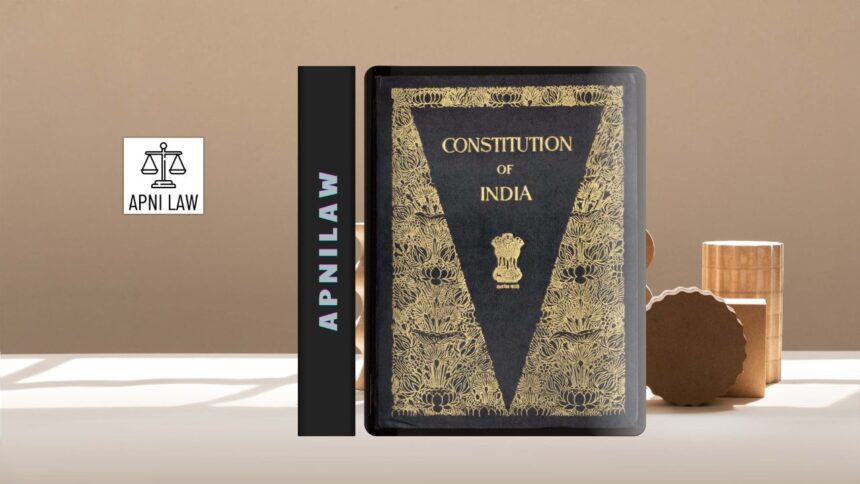Introduction
The Indian Constitution is one of the most remarkable documents in modern political history. Adopted on 26 November 1949 and enforced on 26 January 1950, it established the foundation of the world’s largest democracy. However, while its strengths are often praised, critics have pointed out several flaws. The most common criticisms are that the Constitution is too detailed and at the same time too rigid in certain aspects. These critiques have generated debate for decades, raising questions about whether the Constitution’s structure truly balances flexibility with stability.
Why the Constitution Is Considered Detailed
The Indian Constitution is the longest written Constitution in the world. At the time of adoption, it contained 395 Articles and 8 Schedules, spread across multiple parts and chapters. Today, after several amendments, it has more than 450 Articles and 12 Schedules. Critics argue that such detail makes the Constitution appear more like a legal code than a framework of governance.
The framers included provisions on matters that in many other countries are left to ordinary legislation. Examples include the structure of panchayats, rules about citizenship, and even detailed emergency provisions. By doing so, the Constituent Assembly attempted to cover every possible situation that the new Republic might face. However, this level of detail has led to claims that the Constitution restricts the Parliament from freely making ordinary laws and burdens it with constant amendments.
The Need for Such Detail
Supporters of the Constitution argue that India’s unique conditions justified this length. Unlike countries with homogenous societies, India was a newly independent, diverse nation facing partition, poverty, and deep social inequalities. The framers, led by Dr. B.R. Ambedkar, believed that a broad framework would not be enough. They wanted to ensure protection for minorities, guarantee social justice, and prevent misuse of power.
The inclusion of detailed provisions was therefore intentional. For instance, Fundamental Rights were clearly defined to prevent arbitrary state action. Similarly, Directive Principles of State Policy were included to guide governance toward welfare. Thus, what some call excessive detail can also be seen as a safeguard for democracy in a society as diverse as India.
Criticism of Rigidity
While the Constitution has been amended more than 100 times, it is often criticized as being rigid. The amendment procedure under Article 368 requires a special majority in Parliament, and in some cases, ratification by at least half of the state legislatures. This makes constitutional reform a lengthy and politically difficult process.
Critics argue that this rigidity slows down necessary reforms. For example, changes in the distribution of powers between the Union and the States require significant political consensus. In a country as large and diverse as India, achieving such consensus is rarely easy. This has led to accusations that the Constitution sometimes fails to adapt quickly to changing social and economic needs.
Balancing Flexibility and Rigidity
At the same time, it would be unfair to claim that the Constitution is too rigid without acknowledging its flexibility. The framers carefully designed the amendment procedure to allow reforms while preventing frequent changes that could destabilize governance. Unlike the U.S. Constitution, which is extremely rigid, the Indian Constitution has allowed over a hundred amendments.
For example, the 42nd Amendment (1976) added the words Socialist, Secular, and Integrity to the Preamble, while the 73rd and 74th Amendments (1992) created a framework for local self-governments. These changes show that the Constitution is flexible when needed, but only through a democratic process that respects consensus.
Too Much Borrowing from Other Constitutions?
Another common criticism is that the Indian Constitution borrowed too heavily from foreign models. Provisions relating to Fundamental Rights came from the U.S., the Parliamentary system from the U.K., Directive Principles from Ireland, and emergency powers from Germany. Critics argue that this lack of originality makes the Constitution less reflective of India’s own traditions.
However, this view ignores the fact that the framers did not copy provisions blindly. They studied multiple constitutions and adapted features to India’s conditions. For instance, while borrowing the parliamentary system, they also ensured a strong central government to maintain unity. Thus, borrowing was not a weakness but a deliberate act of selecting the best global practices.
Length vs. Accessibility
The detailed nature of the Constitution has also raised concerns about accessibility. Ordinary citizens may find it difficult to read and understand the lengthy provisions. This can create a gap between constitutional ideals and public awareness. Critics say that a shorter, principle-based Constitution would have been easier to understand and more engaging for the masses.
Yet, the framers considered accessibility in another sense. By writing down detailed provisions, they made sure that rights, powers, and responsibilities were clearly stated. This left less room for ambiguity or arbitrary interpretation. In a newly independent country with low literacy levels, this clarity was necessary to protect vunerable groups.
Impact of Criticism on Constitutional Development
Despite these criticisms, the Indian Constitution has proved remarkably resilient. Its detailed structure has allowed it to adapt to different challenges, from economic reforms to political crises. The criticism of rigidity has also led to judicial innovations like the basic structure doctrine established in the Kesavananda Bharati Case (1973). This doctrine prevents Parliament from altering the Constitution’s core values, such as democracy and secularism, while still allowing other reforms.
Thus, both criticisms, of being too detailed and too rigid, have actually contributed to the Constitution’s growth. They have forced courts, lawmakers, and citizens to constantly debate and reinterpret the document in light of new realities.
Conclusion
The Indian Constitution is often criticized as being too detailed or too rigid. Yet, these very features have also been its strength. The detail ensures protection for diverse groups and prevents arbitrary rule, while the carefully balanced rigidity safeguards democracy from impulsive or authoritarian changes. Rather than seeing these criticisms as flaws, it is better to view them as reflections of India’s unique challenges as a diverse and democratic nation.
Seventy-five years later, the Constitution remains a living document dapting, evolving, and guiding India while still holding firm to its basic ideals of justice, liberty, equality, and fraternity.
For any specific query call at +91 – 8569843472








